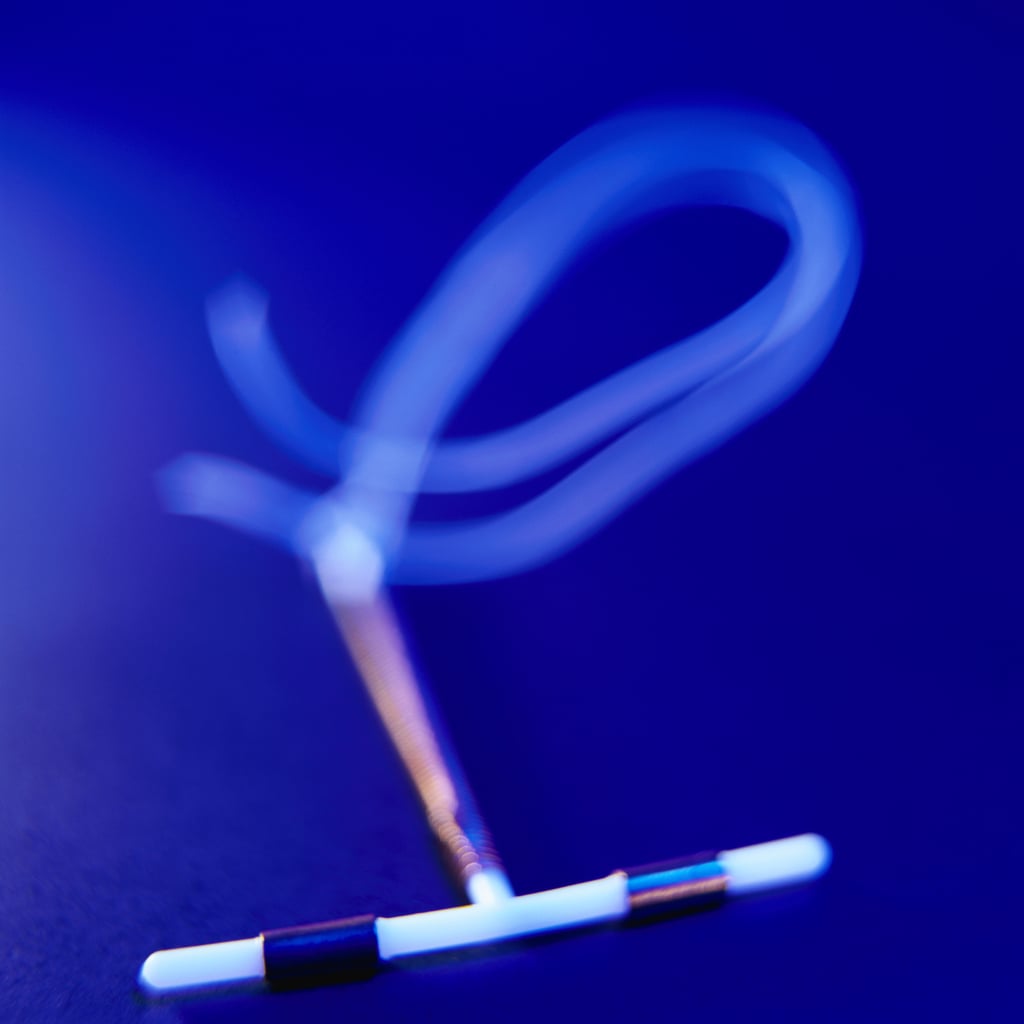IUDs are known as one of the most convenient and effective [1] forms of birth control, but it's true that the insertion process can be unpleasant, uncomfortable, or downright painful for some people. The IUD itself is a small, flexible, T-shaped birth control device that's inserted directly into your uterus. For a lot of people, that alone is (understandably) a little scary. The best way to get more comfortable with the concept, and to prepare for the big insertion day, is to get familiar with the process. What can you expect from your IUD insertion [2]? How can you prepare? Doing some research and talking to your ob-gyn beforehand can help relieve some of your nerves and give you an idea of what the insertion will be like for you.
What Happens During an IUD Insertion?

The first thing to know is that you won't get your IUD inserted during the first appointment you make. First, you'll schedule a time to talk with your ob-gyn or care provider about your overall health and the consent process, said Erica Cahill, MD, an ob-gyn and co-host of the V-Word podcast [3]. Once you've gone over all your birth control options and officially decided on an IUD, you'll make an appointment for the procedure. Dr. Cahill laid out what you can expect from the insertion process.
- First, you'll get a pelvic exam so your care provider can feel the size and shape of your uterus. Wearing gloves, they'll insert two fingers into your vagina while using the other hand to feel your abdomen.
- Your care provider will insert a speculum, a duck bill-shaped device, into your vagina. The speculum will hold your vagina open during the insertion. Your provider may also check for STIs like gonorrhea and chlamydia at this point.
- They'll clean your cervix (the opening to your uterus or womb) using a swab and some cleaning solution.
- Your care provider will insert a tenaculum, a tool used to keep your cervix in place.
- Now, your care provider will insert the IUD. They'll slide the IUD inserter (a long, thin tube) through your cervical canal and into your uterus, making sure it's all the way at the top of the uterus. At this point, you may feel some intense cramping. "I always have patients take three deep breaths during this section," Dr. Cahill said.
- Your care provider will release the IUD and remove the inserter, leaving the IUD inside.
- The strings of the IUD will be cut down to just a few centimeters long. These strings lay outside of your cervix and allow your provider to remove the IUD, when necessary, and check that it's still in place. (You shouldn't be able to feel them.)
- The speculum comes out and you're all done.

Will the IUD Insertion Be Painful?

"Everyone's body is different and everyone's experience of pain is different," Dr. Cahill said. You can't be 100 percent sure whether the IUD insertion will be painful for you until it happens, but there are a few common factors that appear to be linked with pain upon insertion, Dr. Cahill told POPSUGAR. You might be more likely to feel pain if:
- You have a pre-existing pelvic pain syndrome, like endometriosis [5].
- You have a history of anxiety [6].
- You have a history of difficulty with pelvic exams.
- You have a history of sexual assault.
- You're an adolescent.
You may be less likely to feel pain upon IUD insertion if:
- You've given birth.
- You are able to tolerate pelvic exams without difficulty.

Will There Be Pain After My IUD Insertion?

In the first 24 hours after your insertion, you can expect cramping and some light bleeding, Dr. Cahill told POPSUGAR. Your uterus is pretty much trying to get rid of the IUD at this point, which is what brings about those cramps and any pain you might feel, but those symptoms should begin to ease after that first 24-hour period.
After that, it can take "anywhere from three weeks to three months for the IUD to really 'settle' in your uterus," Dr. Cahill said. "During that time, it is normal to have some cramping and irregular bleeding," which can range from light spotting to heavier bleeding.
One scary side effect you may have heard of is known as the "vaso-vagal reaction": feeling light-headed or fainting right after the IUD insertion. This can actually happen anytime someone touches your cervix, not just during an IUD insertion, because the nerves in your cervix are connected to the vagus nerve, which controls your heartbeat.
"Sometimes touching the cervix can make your heart beat slow down suddenly, giving you a light-headed feeling," Dr. Cahill explained. In rare cases, your heartbeat can decrease to the point of passing out. When you hear of people fainting from an IUD insertion, it's from this nervous system reaction, not from the amount of pain. Your care provider knows about this potential reaction going in and will have you lie down for a few minutes after the procedure until you feel OK to sit up, Dr. Cahill said.
After the procedure is over, there are a few symptoms you should keep an eye out for. Call your doctor if you experience any of the following:
- Severe pain that can't be controlled with pain medication, like ibuprofen and acetaminophen (such as Tylenol).
- Heavy bleeding that soaks through more than two pads in an hour.
- Fever.
- Chills.
Pay attention to anything that just doesn't feel right to you, Dr. Cahill said. Don't hesitate to call your doctor if you have questions.

What It Feels Like to Get an IUD

Insertion experiences vary widely and for some people, there's no way to sugarcoat it: the pain is extreme. "I thought I was walking out of the doctor's office after getting my first IUD but rejected that option on account of my legs not working afterward," said POPSUGAR writer Hilary White in a personal essay on her IUD insertion [9]. "In a haze of cramps and irrational 'is someone stabbing my uterus' thoughts, I also contemplated crawling out."
POPSUGAR writer Jenny Sugar, on the other hand, wrote that "my insertion could be summed up as 10 full seconds of not-quite-as-excruciating-as-labour-but-pretty-damn-painful cramps." (Here's what the removal process was like [10] for her as well.)
"I actually didn't think it was that painful at all," wrote contributor Maggie McCracken. "The implantation went well, the discomfort was minor, and I walked out of the office feeling great." She noted that anxiety over the IUD's placement led to her decision to get it removed [11].
"Though I felt a deep cramping in my stomach during the 30 seconds the actual insertion lasted (and hollered out a string of profanities like Steve Carell [12] in the 40-Year-Old Virgin waxing scene), the whole process was about as long and painless as a pap smear [13]," shared contributor Corinne Sullivan about her own experience [14].
Bottom line: the pain can range from slight to excruciating cramps, and not knowing which way your insertion will go can lead to major anxiety. Though we can't predict exactly what you'll feel, there are a few ways you can prepare and go in with as much comfort and confidence as possible.
Should I Check My IUD?

Your care provider will likely offer you a follow-up appointment about a week after your insertion to make sure your IUD is still in the right spot. "We do this exam with either a speculum to directly see the strings, or sometimes an ultrasound to see that the IUD is in the right place inside the uterus," said Jenn Conti, MD, an ob-gyn and co-host of the V Word podcast. This is also a great chance to ask any questions you might have about the IUD and side effects.
You can also check on your IUD strings yourself, something you can do as soon as you're up to it after the insertion. To do so, wash your hands and insert your first two fingers into your vagina, as far as they can go. "Move them around until you can feel something that feels like super fine fishing line," Dr. Conti said; those are the strings. "They're often curled up around the cervix, so you may have to sweep behind or in front of it with your fingers a little."
Dr. Conti recommended checking your strings about once a month. If you can't feel them, let your doctor know; it might be that they're curled too tightly or have receded a bit into the cervix. If you could previously feel the strings and can't anymore, that's a reason to schedule a check-up, Dr. Conti said. It's possible that your IUD has moved around in your uterus or perforated the uterine wall. You should also schedule a check-up if you notice a sudden change in your bleeding pattern, Dr. Conti said. (For example, if you had lighter periods on a hormonal IUD and they've suddenly gotten heavier.)
As for how long it takes for IUDs to prevent pregnancy (aka how long you should wait to be sexually active again), Dr. Conti told POPSUGAR that the copper IUD is effective right away. If you had your hormonal IUD (such as Mirena, Liletta, Kyleena, or Skyla) inserted within seven days of the start of your period, it's also effective immediately. "Otherwise you should use a back-up method like condoms for the first 7 days," Dr. Conti said.
How to Prepare For Your IUD Insertion

If you're worried about pain or side effects of IUD insertion, ask your provider what you can do to minimize discomfort. Here are some strategies Dr. Cahill suggested:
- Make sure you've had all your questions answered and are comfortable with your provider beforehand.
- Consider bringing a partner, parent, or close friend for extra support.
- Hold your support person's hand.
- Ask your provider to narrate what they're doing.
- If you'd rather be distracted, ask your provider if you can listen to music or watch a video on your phone.
Beyond that, a lot of the prepping for your IUD insertion is mental. Do you know what to expect? Do you have all your questions answered? Talk to your care provider about ways you can make the environment as comfortable as possible, both before and after the procedure. "I would encourage people to prepare to be very low-key after their IUD insertion," Dr. Cahill said. "Don't make big plans afterwards, as you may just feel like lying down."
Though there are a few factors that can help predict whether you'll feel pain during the insertion, there's no way to know exactly what it'll be like for you. That's understandably frustrating, and the stress of not knowing can make your nerves even worse beforehand. It's not easy, but one of the best things you can do is relax. "Most of the build up before the insertion is anxiety-related," said Dr. Conti.
For many people, the convenience and effectiveness of an IUD [15] ends up being worth the pain of the insertion, as rough as it can be. Ask questions, be prepared, and make yourself as comfortable as possible. Dr. Conti told POPSUGAR, "Bring your headphones, deep breathing skills, and anything else you find helps you relax, and you'll be just fine."